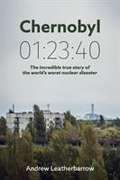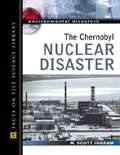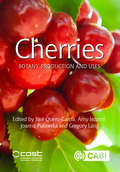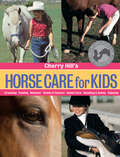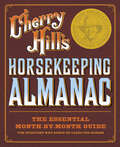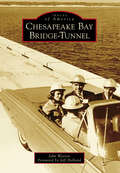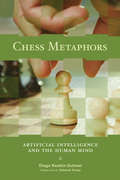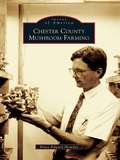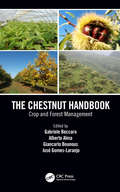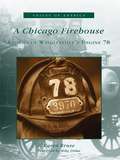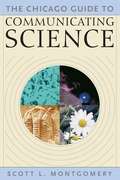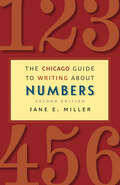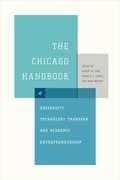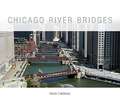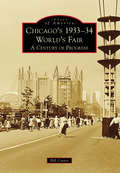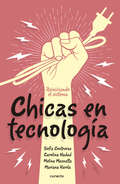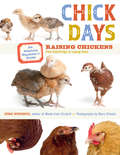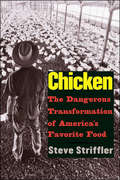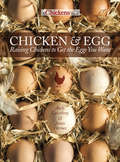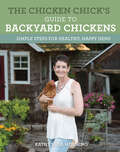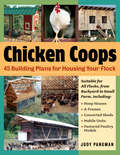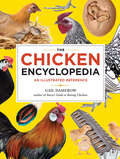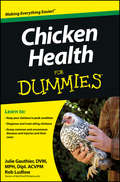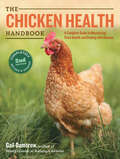- Table View
- List View
Chernobyl 01: The Incredible True Story Of The World's Worst Nuclear Disaster
by Andrew Leatherbarrow Elizabeth PetreyAt 01:23:40 on April 26th 1986, Alexander Akimov pressed the emergency shutdown button at Chernobyl's fourth nuclear reactor. It was an act that forced the permanent evacuation of a city, killed thousands and crippled the Soviet Union. The event spawned decades of conflicting, exaggerated and inaccurate stories. <p><p> This book, the result of five years of research, presents an accessible but comprehensive account of what really happened. From the desperate fight to prevent a burning reactor core from irradiating eastern Europe, to the self-sacrifice of the heroic men who entered fields of radiation so strong that machines wouldn't work, to the surprising truth about the legendary 'Chernobyl divers', all the way through to the USSR's final show-trial. The historical narrative is interwoven with a story of the author's own spontaneous journey to Ukraine's still-abandoned city of Pripyat and the wider Chernobyl Zone. <p> Complete with over 45 pages of photographs of modern-day Pripyat and technical diagrams of the power station, Chernobyl 01:23:40 is a fascinating new account of the world's worst nuclear disaster.
The Chernobyl Nuclear Disaster
by Scott IngramThe world's worst nuclear power accident occurred on April 26, 1986, and had lasting repercussions in all areas of human life. This book details the events leading up to the Chernobyl nuclear power plant disaster, the causes of the explosion, and the ensuing fallout, both immediate and long-term. The social, economic, and political consequences of the disaster are discussed, and the catastrophic environmental and health effects on people living in the region are recounted in detail.
Cherries
by J. Quero-García Amy Iezzoni Joanna Puławska Gregory LangSweet and sour cherries (Prunus avium and Prunus cerasus) are important fruit crops for which demand is high and growing. A significant number of new varieties, rootstocks and training systems have been released or developed in recent years in order to improve the efficiency and profitability of cherry orchards. Cherries: Botany, Production and Uses covers the genetics, ecophysiology, production, protection and uses of cherries. Presenting up-to-date scientific data and applied information, this book is invaluable for researchers, teachers and all professionals working in the cherries value chain.
Cherry Hill's Horse Care for Kids: Grooming, Feeding, Behavior, Stable & Pasture, Health Care, Handling & Safety, Enjoying
by Cherry HillCovering the essentials of equine care in a language appropriate for teen and preteen horse lovers, this guide provides everything young equestrians need to know to safely and enjoyably keep their horse healthy and happy. Veteran trainer Cherry Hill starts by making sure that the right animal is matched with the right rider, then progresses through feeding, grooming, behavior, safety, and health care. Encouraging their passion, Hill provides a roadmap for young horse enthusiasts to responsibly care for their cherished companion.
Cherry Hill's Horsekeeping Almanac: The Essential Month-by-Month Guide for Everyone Who Keeps or Cares for Horses
by Cherry HillKeep your horse happy and healthy throughout the entire year. Veteran trainer Cherry Hill provides a comprehensive month-by-month guide to horse care that includes seasonal stable chores and maintenance procedures that promote equine health. Reminding you to check for ticks in April, buy hay in July, and set up winter bedding in October, each month&’s reference charts, to-do lists, and climate notes will help you establish routines that follow the natural cycles of the animals and the land.
Chesapeake Bay Bridge-Tunnel (Images of America)
by John Warren Jeff HollandAt its opening in 1964, the Chesapeake Bay Bridge-Tunnel was named one of the "Five Wonders of the Modern World" by Reader's Digest magazine. It was the culmination of a concerted, decade-long push by a group of men, led by Lucius J. Kellam Jr., an Eastern Shore native and businessman who dreamed of opening up the remote Eastern Shore to the bustling Virginia mainland. This $200-million, 17.6-mile-long series of bridges, tunnels, islands, and trestle in the middle of the Chesapeake Bay--long dismissed as impractical and even impossible--won the attention of the world at its opening. It also brought an abrupt end to the ferry service that was long a cornerstone of the New York-to-Florida "Ocean Highway," shuttling millions of cars between the Eastern Shore and Hampton Roads.
Chess Metaphors: Artificial Intelligence and the Human Mind
by Diego Rasskin-GutmanHow the moves of thirty-two chess pieces over sixty-four squares can help us understand the workings of the mind. When we play the ancient and noble game of chess, we grapple with ideas about honesty, deceitfulness, bravery, fear, aggression, beauty, and creativity, which echo (or allow us to depart from) the attitudes we take in our daily lives. Chess is an activity in which we deploy almost all our available cognitive resources; therefore, it makes an ideal laboratory for investigation into the workings of the mind. Indeed, research into artificial intelligence (AI) has used chess as a model for intelligent behavior since the 1950s. In Chess Metaphors, Diego Rasskin-Gutman explores fundamental questions about memory, thought, emotion, consciousness, and other cognitive processes through the game of chess, using the moves of thirty-two pieces over sixty-four squares to map the structural and functional organization of the brain. Rasskin-Gutman focuses on the cognitive task of problem solving, exploring it from the perspectives of both biology and AI. Examining AI researchers' efforts to program a computer that could beat a flesh-and-blood grandmaster (and win a world chess championship), he finds that the results fall short when compared to the truly creative nature of the human mind.
Chester County Mushroom Farming
by Bruce Edward MowdayChester County is well known for its sprawling scenic views, rich farmland, the Main Line, and mushrooms. Chester County, and specifically the village of Kennett Square, is known as the mushroom capital of the world because of the quantity and quality of mushrooms grown there. Mushrooms have been around for centuries, with the French beginning cultivation in the 1600s, and mushroom farming began in Chester County more than 120 years ago. The earliest farmers were Quakers, but over the years members of the Irish, Italian, and Hispanic communities have joined the ranks of Chester County mushroom farmers. The local mushroom farmers were responsible for the forming of the American Mushroom Institute more than a half century ago.
The Chestnut Handbook: Crop & Forest Management
by Gabriele Beccaro Alberto Alma Giancarlo Bounous Jose Carlos LaranjoChestnut Management and Production shares achievements in chestnut development and cultivation including information on sustainable planning and management of chestnut production from nursery to plantation, entomology, pathology, and ecosystem services. Cultivation techniques of Chinese, Japanese, and European chestnut species including hybrids are described containing information on over 550 local and commercial cultivars. Beautiful original handmade drawings and technical sheets facilitate accessibility and comprehension of information.
A Chicago Firehouse: Stories of Wrigleyville's Engine 78 (Voices of America)
by Mike Ditka Karen KruseFrom its humble beginnings in 1884 as a one-story frame building with one bay to house Hose Company 4 and its team of horses, Engine Company 78 has been the firefighting sentinel at the end of Waveland Avenue, sitting in the shadow of Wrigley Field. Using vintage photographs and moving stories from firefighters themselves, Karen Kruse captures the spirit and heroism of this historic Chicago landmark. Captain Robert F. Kruse served the Chicago Fire Department for 30 years, half of those at Wrigleyville's Engine 78. Growing up within the tight-knit firefighting community, Ms. Kruse records the dramatic and touching stories from her father's and his peers' experiences, and combines them in this volume exploring the unique history of Lakeview's firehouse, including a foreword by Mike Ditka and preface by Fire Commissioner James Joyce. With details about little known historic districts and a brief guide to Chicago's cemeteries and their relations to firefighters, A Chicago Firehouse: Stories of Wrigleyville's Engine 78 relays in first-hand accounts some of Chicago's most fiery tragedies, the brave men who battled them, and the diversity of the neighborhood that housed them.
The Chicago Guide to Communicating Science
by Scott L. MontgomeryThis book offers detailed, practical advice on crafting every sort of scientific communication, from research papers and conference talks to review articles, interviews with the media, e-mail messages, and more.
The Chicago Guide to Writing about Numbers
by Jane E. MillerPeople who work well with numbers are often stymied by how to write about them. Those who don't often work with numbers have an even tougher time trying to put them into words. For instance, scientists and policy analysts learn to calculate and interpret numbers, but not how to explain them to a general audience. Students learn about gathering data and using statistical techniques, but not how to write about their results. And readers struggling to make sense of numerical information are often left confused by poor explanations. Many books elucidate the art of writing, but books on writing about numbers are nonexistent. Until now. Here, Jane Miller, an experienced research methods and statistics teacher, gives writers the assistance they need. The Chicago Guide to Writing about Numbers helps bridge the gap between good quantitative analysis and good expository writing. Field-tested with students and professionals alike, this book shows writers how to think about numbers during the writing process. Miller begins with twelve principles that lay the foundation for good writing about numbers. Conveyed with real-world examples, these principles help writers assess and evaluate the best strategy for representing numbers. She next discusses the fundamental tools for presenting numbers--tables, charts, examples, and analogies--and shows how to use these tools within the framework of the twelve principles to organize and write a complete paper. By providing basic guidelines for successfully using numbers in prose, The Chicago Guide to Writing about Numbers will help writers of all kinds clearly and effectively tell a story with numbers as evidence. Readers and writers everywhere will be grateful for this much-needed mentor.
The Chicago Guide to Writing about Numbers; Second Edition (Chicago Guides to Writing, Editing, and Publishing)
by Jane E. MillerEarning praise from scientists, journalists, faculty, and students, The Chicago Guide to Writing about Numbers has helped thousands of writers communicate data clearly and effectively. Its publication offered a much-needed bridge between good quantitative analysis and clear expository writing, using straightforward principles and efficient prose. With this new edition, Jane Miller draws on a decade of additional experience and research, expanding her advice on reaching everyday audiences and further integrating non-print formats. Miller, an experienced teacher of research methods, statistics, and research writing, opens by introducing a set of basic principles for writing about numbers, then presents a toolkit of techniques that can be applied to prose, tables, charts, and presentations. Throughout the book, she emphasizes flexibility, showing writers that different approaches work for different kinds of data and different types of audiences. The second edition adds a chapter on writing about numbers for lay audiences, explaining how to avoid overwhelming readers with jargon and technical issues. Also new is an appendix comparing the contents and formats of speeches, research posters, and papers, to teach writers how to create all three types of communication without starting each from scratch. An expanded companion website includes new multimedia resources such as slide shows and podcasts that illustrate the concepts and techniques, along with an updated study guide of problem sets and suggested course extensions. This continues to be the only book that brings together all the tasks that go into writing about numbers, integrating advice on finding data, calculating statistics, organizing ideas, designing tables and charts, and writing prose all in one volume. Field-tested with students and professionals alike, this holistic book is the go-to guide for everyone who writes or speaks about numbers.
The Chicago Handbook of University Technology Transfer and Academic Entrepreneurship
by Mike Wright Albert N. Link Donald S. SiegelAs state support and federal research funding dwindle, universities are increasingly viewing their intellectual property portfolios as lucrative sources of potential revenue Nearly all research universities now have a technology transfer office to manage their intellectual property, but many are struggling to navigate this new world of university-industry partnerships. Given the substantial investment in academic research and millions of dollars potentially at stake, identifying best practices in university technology transfer and academic entrepreneurship is of paramount importance. The Chicago Handbook of University Technology Transfer and Academic Entrepreneurship is the first definitive source to synthesize state-of-the-art research in this arena. Edited by three of the foremost experts in the field, the handbook presents evidence from entrepreneurs, administrators, regulators, and professors in numerous disciplines. Together they address the key managerial and policy implications through chapters on how to sustain successful research ventures, ways to stimulate academic entrepreneurship, maintain effective open innovation strategies, and improve the performance of university technology transfer offices. A broad and ambitious work, the handbook offers comprehensive coverage for universities of all types, allowing them to confidently handle technology commercialization and further cultivate innovation.
Chicago River Bridges
by Patrick T. McbriartyChicago River Bridgespresents the untold history and development of Chicago's iconic bridges, from the first wood footbridge built by a tavern owner in 1832 to the fantastic marvels of steel, concrete, and machinery of today. It is the story of Chicago as seen through its bridges, for it has been the bridges that proved critical in connecting and reconnecting the people, industry, and neighborhoods of a city that is constantly remaking itself. In this book, author Patrick T. McBriarty shows how generations of Chicagoans built (and rebuilt) the thriving city trisected by the Chicago River and linked by its many crossings. This comprehensive guidebook chronicles more than 175 bridges spanning 55 locations along the Main Channel, South Branch, and North Branch of the Chicago River. With new full-color photography of existing bridges and more than one hundred black and white images of bridges past, the book unearths the rich history of Chicago's downtown bridges from the Michigan Avenue Bridge to the often forgotten bridges that once connected thoroughfares such as Rush, Erie, Taylor, and Polk Streets. Throughout, McBriarty delivers new research into the bridges' architectural designs, engineering innovations, and their impact on Chicagoans' daily lives, explaining how the dominance of the "Chicago-style" bascule drawbridge influenced the style and mechanics of bridges worldwide. Interspersed throughout are the human dramas that played out on and around the bridges, such as the floods of 1849 and 1992, the cattle crossing collapse of the Rush Street Bridge, or Vincent "The Schemer" Drucci's Michigan Avenue Bridge jump. A confluence of Chicago history, urban design, and engineering lore, Chicago River Bridges illustrates Chicago's significant contribution to drawbridge innovation and the city's emergence as the drawbridge capital of the world.
Chicago's 1933-34 World's Fair: A Century of Progress
by Bill CotterIt took six years and cost $100 million, but on May 27, 1933, the gates swung open on the biggest birthday party the city of Chicago had ever seen. The Century of Progress Exposition, better known as the 1933-34 Chicago World's Fair, commemorated the amazing progress that had been made since the founding of the city just 100 years earlier. Many of America's largest companies joined with countries from around the world to showcase their histories and advertise their newest products. The road to opening day was not an easy one, with the Great Depression making it look like the fair might never be built, but thousands of small investors stepped forward to help close the financial gap. The fair went on to an unprecedented second season, and when the gates finally closed after the last of the 39 million visitors went home, it had achieved something quite rare among world's fairs: earning a profit. This collection of rare photographs, previously unpublished, highlights the major attractions of the fair and the astonishing changes made between seasons.
Chicas en Tecnología®: Reiniciando el sistema
by Mariana Varela Carolina Hadad Sofía ContrerasLa tecnología tiene un papel determinante en lo cotidiano: el trabajo, la educación y la vida social. Pero es un área desigual para las mujeres. Este libro da cuenta de la brecha de género en tecnología y de la invisibilización de las pioneras y las líderes, pero es también una invitación a reiniciar el sistema, a que las mujeres consideren a la tecnología como una aliada para mejorar el mundo. La tecnología tiene un papel determinante en lo cotidiano: el trabajo, la educación y la vida social. Pero es un área profundamente desigual para las mujeres. La disparidad comienza en la infancia -a las niñas les regalan una cocinita y a los niños, videojuegos- y continúa durante la escolarización, la formación profesional, la capacitación, en el ambiente laboral o cuando deciden emprender. Las mujeres chocan constantemente con la estigmatización, la mirada estereotipada, la brecha salarial, discriminación y violencia. Cuando en 2015 Sofía Contreras, Carolina Hadad, Melina Masnatta y Mariana Varela crearon la organización Chicas en Tecnología® con el objetivo de achicar la brecha de género en ese campo, el feminismo no tenía la fuerza de hoy en la escena pública, y si bien se ganaron derechos, aún falta mucho. Con datos, fuentes, investigaciones, análisis y la experiencia de las autoras, este libro evidencia las barreras que las mujeres enfrentan en el ambiente tecnológico, pero además propone cambios e ideas en educación, liderazgo, emprendedorismo, mentoreo. Rescata de la invisibilización a las pioneras y demuestra por qué es fundamental que haya cada vez más líderes mujeres y multiplicidad de voces. Chicas en Tecnología® es una invitación a reiniciar el sistema, a que las mujeres consideren a la tecnología como una aliada para mejorar el mundo.
Chick Days: An Absolute Beginner's Guide to Raising Chickens from Hatching to Laying
by Jenna Woginrich Mars VilaubiJenna Woginrich chronicles the life journey of three chickens (Amelia, Honey, and Tilda) from fluffy, newly hatched bundles to grown hens laying eggs of their own. As you watch these chickens grow, you’ll learn everything you need to know about chicken behavior, feeding, housing, and health care. This playfully informative guide will inspire you to confidently raise your own feathered flock.
Chicken: The Dangerous Transformation of America's Favorite Food
by Steve StrifflerAnthropologist Steve Striffler begins this book in a poultry processing plant, drawing on his own experiences there as a worker. He also reports on the way chickens are raised today and how they are consumed. What he discovers about America's favorite meat is not just unpleasant but a powerful indictment of our industrial food system. The process of bringing chicken to our dinner tables is unhealthy for all concerned, from farmer to factory worker to consumer. The book traces the development of the poultry industry since the Second World War, analyzing the impact of such changes as the destruction of the family farm, the processing of chicken into nuggets and patties, and the changing makeup of the industrial labor force. The author describes the lives of immigrant workers and their reception in the small towns where they live. The conclusion is clear: there has to be a better way. Striffler proposes radical but practical change, a plan that promises more humane treatment of chickens, better food for the consumer, and fair payment for food workers and farmers.
Chicken and Egg
by Kate Osborne James Hermes Andy CawthrayThe age-old question of which comes first is finally answered in Chicken and Egg! For the purposes of egg-centric chicken keepers, it's the egg! A new approach to chicken keeping, Chicken and Egg is specifically geared toward hobby farmers and casual chicken keepers who wish to produce eggs of a particular color, flavor, and type. Whether the reader desires the delectable turquoise eggs of the Araucana or the chocolate brown eggs of the Blue Copper Maran, learn how it's possible to put the egg before the chicken. Written by two expert poultry breeders and specialists, Andy Cawthray and James Hermes, this new colorful handbook offers an edifying overview of the natural history of chickens and the science of egg production so that keepers better understand how to care for egg-layers, improve the quality of their eggs through diet and housing, and maximize their egg production for years to come. The authors have rounded up a few dozen chicken breeds and offer their hardboiled advice about which hens offer the most egg-cellect daily output.-Directory of the best egg-laying chicken breeds, plus colorful two-page spreads of the 20 most popular choices-Advice on how to select and set up your flock, including safe and affordable housing, runs, and coops-Selecting the best diets for your flock to maximize production and avoid egg failure-Essential information about brooding and laying, the birds' behavior, and solving problems within the flock-Specially commissioned artwork from watercolorist and illustrator Kate Osborne
The Chicken Chick's Guide to Backyard Chickens: Simple Steps for Healthy, Happy Hens
by Kathy Shea MorminoThe Chicken Chick’s Guide to Backyard Chickens takes readers through all aspects of small flock care, including feeding, housing, chicken health, and more!Internationally known as The Chicken Chick, Kathy Shea Mormino brings an informative style and fresh perspective on raising backyard chickens to millions of fans around the world. An attorney by profession, Kathy is the founder and one-woman creative force behind her wildly popular and award-winning Facebook page and blog.Sharing her years of hard-earned experience and collaborations with poultry veterinarians, nutritionists, and professors, she provides simple steps to care for these uncommon pets with confidence. Kathy’s personality permeates the book as she guides newbie, veteran, and would-be backyard chickeneers alike in this fun and abundantly illustrated format that she has delivered on her blog for years.
Chicken Coops: 45 Building Ideas for Housing Your Flock
by Judy PangmanJust like houses, chicken coops come in all shapes and sizes. Judy Pangman presents how-to drawings and conceptual plans for 45 coops — from the strictly practical to flights of fancy — guaranteed to meet the needs of every bird owner, however big or small your flock may be. Color photographs and innovative suggestions fill this encouraging guide, while lively anecdotes profile an array of coop builders and their various construction methods. Start building the coop of your chickens’ dreams!
The Chicken Encyclopedia: An Illustrated Reference
by Gail DamerowFrom addled to wind egg and crossed beak to zygote, the terminology of everything chicken is demystified in The Chicken Encyclopedia. Complete with breed descriptions, common medical concerns, and plenty of chicken trivia, this illustrated A-to-Z reference guide is both informative and entertaining. Covering tail types, breeding, molting, communication, and much more, Gail Damerow provides answers to all of your chicken questions and quandaries. Even seasoned chicken farmers are sure to discover new information about the multifaceted world of these fascinating birds.
Chicken Health For Dummies
by Ludlow Julie GauthierEverything you need to care for and keep happy, healthy chickensWith directives on diagnosing and treating sick or ailing chickens, as well as general information on how to keep chickens in peak condition, Chicken Health For Dummies is your go-to guide on how to best care for and keep chickens.Inside, you'll get everything you need to know about chicken health and wellness: an encyclopedia full of common and not-so-common diseases, injuries, symptoms, and cures that chicken owners may encounter. Chicken Health For Dummies provides chicken owners with one handy, all-encompassing resource. Helps you identify potential hazards and signs of ill health in your chickenShows you how to properly examine chickens to identify and isolate potential health issues before they spread to the rest of the flockAn encyclopedia full of common and uncommon diseases, injuries, symptoms, and cures for chickensChicken Health For Dummies joins Raising Chickens For Dummies and Building Chickens Coops For Dummies to round out the For Dummies reference library as a must-have resource for both rural and urban chicken owners.
The Chicken Health Handbook, 2nd Edition: A Complete Guide to Maximizing Flock Health and Dealing with Disease
by Gail DamerowHealthy chickens are happy chickens. This one-of-a-kind reference book covers the health problems that plague chickens of all breeds and ages. Practical charts identify common symptoms and causes of infection, while an alphabetic listing of diseases provides advice on treatment. You’ll find helpful descriptions of troublesome ailments of all types, from poor egg production to crooked toe syndrome. Practical remedies and gentle preventative care measures will help your beloved flock stay happy, healthy, and safe.
